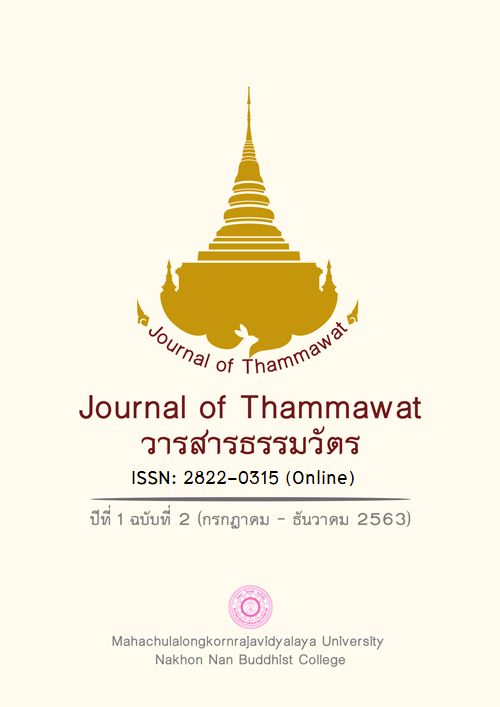Bullying in Buddhism Perspective
Main Article Content
Abstract
Bullying in Buddhism perspective was a problem occurred before Buddha era as evidence in Tripitaka, named Aggañña Sutta, indicated that the first bullying issue was about skin. At present, the situation analysis showed that the bullying could be classified into 4 types: Physical Bullying, Speech Bulling, Social and Emotional Bullying, and Cyberbullying. These was analyzed that they matched with 2 Buddhist dharma principles: 1) Unwholsome Roots 3 because causes of bullying was rooted from greed, hatred, and delusion minds; and 2) Unwholesome Course of Action (false view; wrong view) because they matched with 10 bad karmas which was identified into 3 categories. They are: 2.1) Three Bad Physical Actions – Hitting, Threatening to get asset, and Sexual harassment; 2.2) Four Bad Speech Actions – Lying, Reviling, Slandering, and Mocking; 2.3) Three Bad mental Actions – Greed, Maliciousness, immorality by badly thinking. If they were more collected in mind, it will lead to the physical and speech bullying later. Therefore, paths for coping with the bullying based on Buddhism are consciousness existence, patience for retortation by explanation on the right time, none of tension or too much anxiety, and choosing to live in good environment and society.
Article Details

This work is licensed under a Creative Commons Attribution-NonCommercial-NoDerivatives 4.0 International License.
References
เกษม กสิโอฬาร และ พัชรี ตันติวิภาวิน. (2560). พุทธธรรมพัฒนาจิตเพื่อระงับความโกรธ. วารสารรังสิตบัณฑิตศึกษาในกลุ่มธุรกิจและสังคมศาสตร์. 3(1-2), 31.
กรุงเทพธุรกิจ. (2563). กรมสุขภาพจิต' เผยกลั่นแกล้ง-รังแก (BULLYING) ในโรงเรียน ไม่ใช่เรื่องล้อเล่น.สืบค้น 1 สิงหาคม 2563. จาก https://www. bangkokbiznews.com/news/detail/859102
โกวิทย์ นพพร. (2563). รับมืออย่างไรในสังคม Bully. สืบค้น 1 สิงหาคม 2563. จาก https://www.samitivej-hospitals.com/th/รับมือ-bully/.
เดลินิวส์. (2563). กรมสุขภาพจิตชี้ เด็กถูกบูลลี่เสี่ยงเป็นอาชญากร. สืบค้น 1 สิงหาคม 2563. จาก https://www.dailynews.co.th/regional/747948.
พระเทพเวที (ประยุทธ์ ปยุตฺโต). (2533). พจนานุกรมพุทธศาสน์ ฉบับประมวลศัพท์. (พิมพ์ครั้งที่ 4).กรุงเทพมหานคร: โรงพิมพ์มหาจุฬาลงกรณราชวิทยาลัย.
มหาจุฬาลงกรณราชวิทยาลัย. (2539). พระไตรปิฎกภาษาไทย ฉบับมหาจุฬาลงกรณราชวิทยาลัย. กรุงเทพมหานคร: โรงพิมพ์มหาจุฬาลงกรณราชวิทยาลัย.
มูลนิธิยุวพัฒน์. (2563). การกลั่นแกล้ง (Bullying) ความรุนแรงในสังคม. สืบค้น 1 สิงหาคม 2563. จาก https://www.yuvabadhanafoundation.org/th/ข่าวสาร/บทความทั่วไป/การกลั่นแกล้ง-bullying-วัยรุ่น/.
สำนักราชบัณฑิตยสถาน. (2563). พจนานุกรม ฉบับราชบัณฑิตยสถาน พ.ศ. 2554. สืบค้น 1 สิงหาคม 2563. จาก https://dictionary.apps.royin.go.th/.
BookPlus. Why Bullying? ทำไมถึงต้องกลั่นแกล้ง อะไรคือสาเหตุของพฤติกรรมรุนแรงเหล่านี้?.สืบค้น 1 สิงหาคม 2563. จาก https://bookplus.co.th/why-bullying-ทำไมถึงต้องกลั่นแกล้ง/.
Nature Biotec. ผลกระทบของการ Bully และแนวทางป้องกัน. สืบค้น 1 สิงหาคม 2563. จาก https://www.naturebiotec.com/bully-and-protect20202114/.


